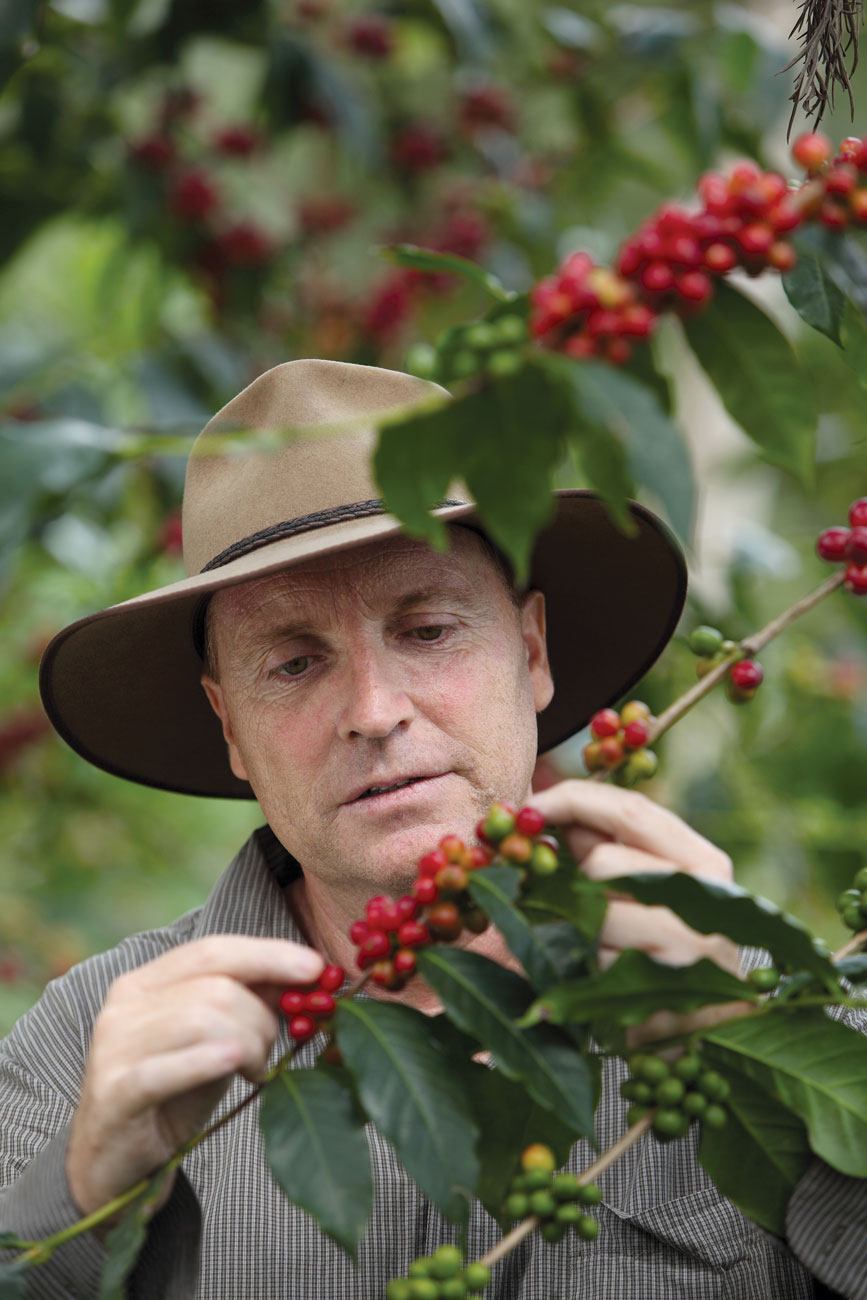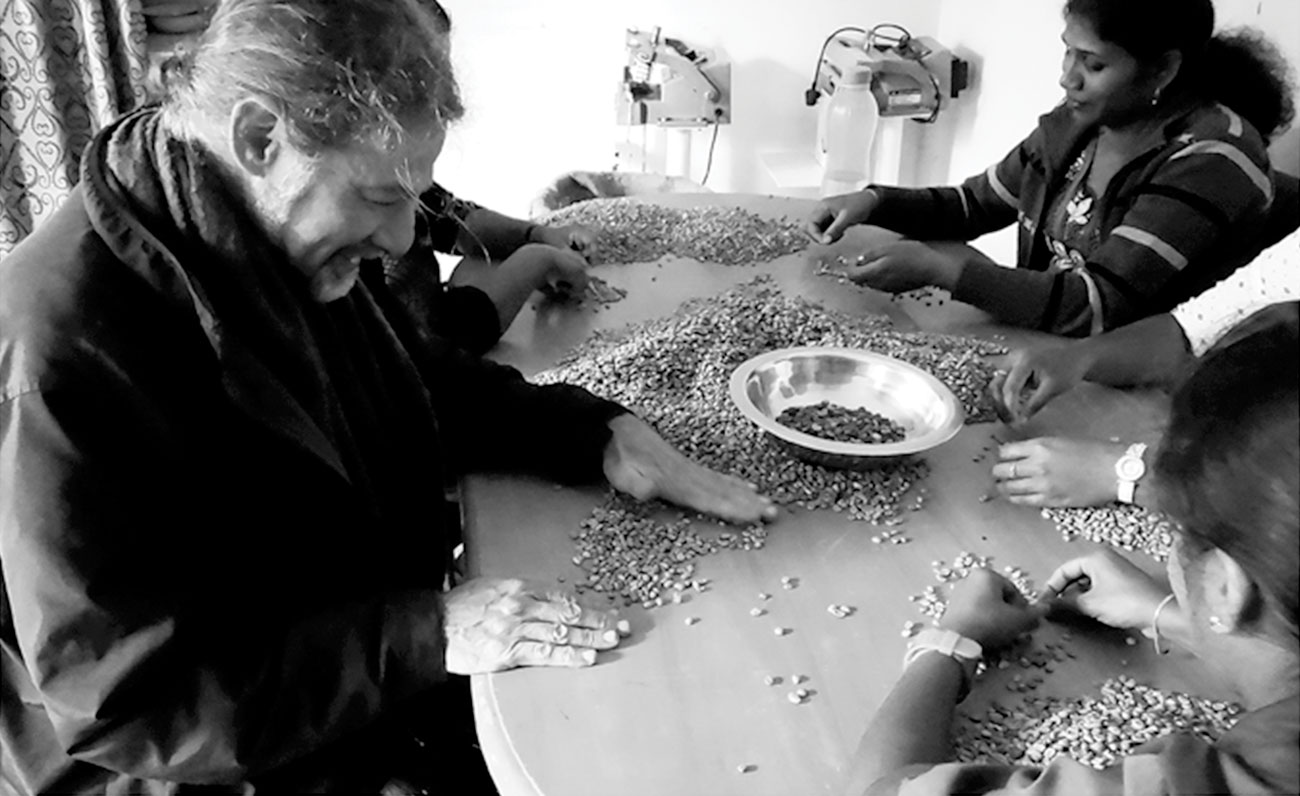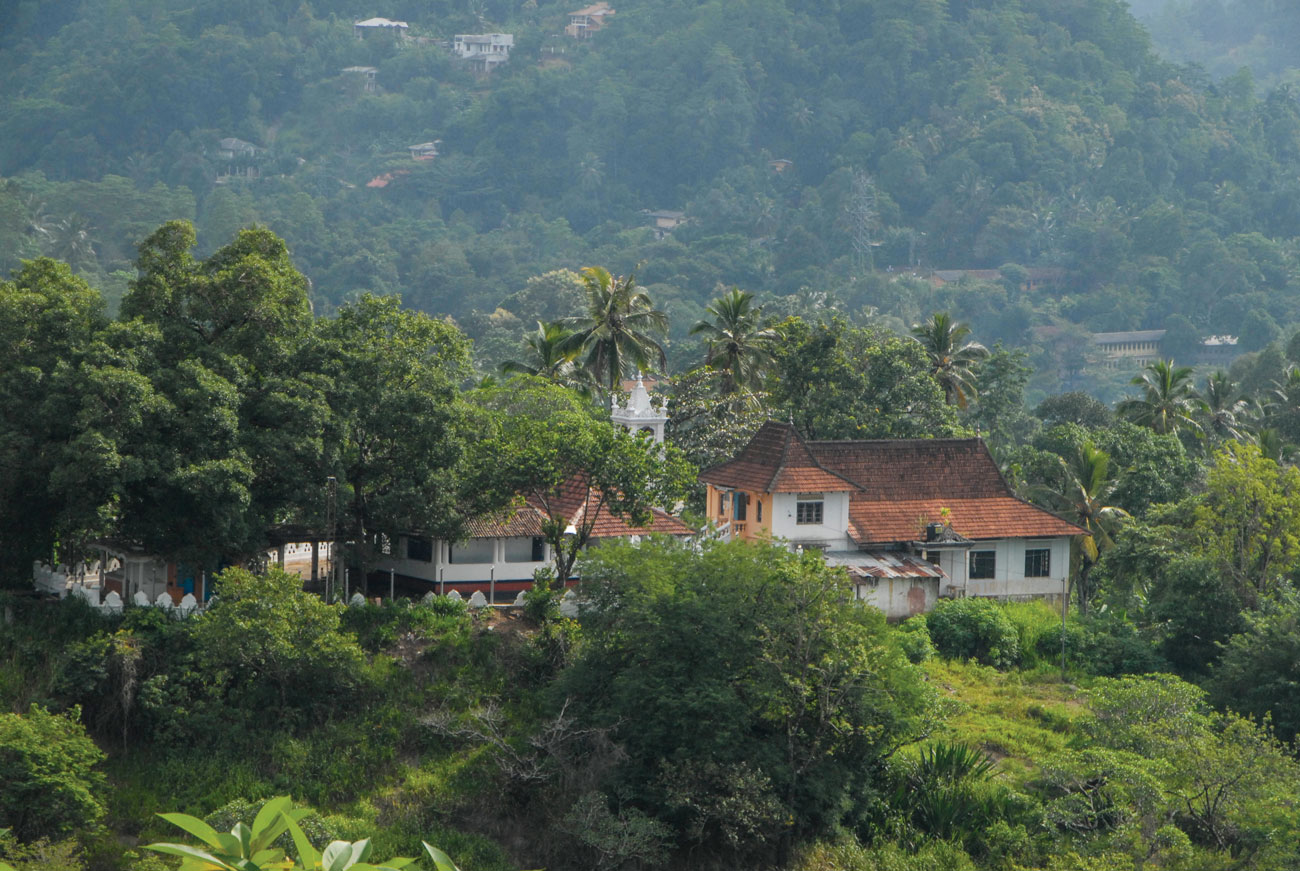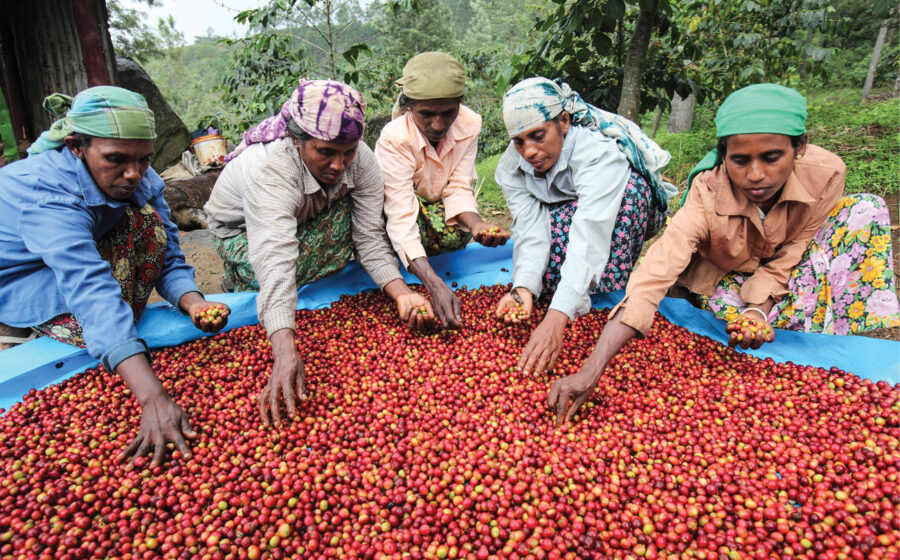[I]f you were to have a table with ten chairs of the ten best coffees in the world, Sri Lanka should be at that table,” Lawrence Goldberg explained, sinking into one of the worn armchairs casually arranged in what constitutes the office of Hansa Ceylon Coffee. The low-slung building is located up the hill from the center of Nuwara Eliya, the largest town in the district of the same name, where the thick fog hangs so low you can see it crowding into the streets. It is here, in this pocket in the center of Sri Lanka, where the coffee industry hopes to be revived after its death nearly 150 years ago.
After being passed from the Dutch to the British Empire, the island—then called Ceylon—established a coffee industry that grew to be one of the world’s three biggest, competing with Brazil and Indonesia. While those are currently number one and number four in exports respectively, Sri Lanka endured an epidemic of coffee leaf rust in the late nineteenth century that devastated plants and forced landowners to convert to tea. With global demand for coffee high, a handful of roasters have been drawn by Sri Lanka’s coffee-growing past, and found an audience of Sri Lankans ready for the drink to return.
It wasn’t nostalgia that brought back Sri Lankans’ interest in the drink. In fact, the first coffee company to arrive on the island’s shore was Nestle. Single-serve machines began popping up in shops or next to food stalls, and families started buying instant coffee to stock the pantry. “Nescafé played its role. It got people to try their first cup of coffee,” said Goldberg’s wife, Shani Hulugalle, who operates Hansa Ceylon’s café in the country’s capital and biggest city, Colombo.
As Nescafé began turning Sri Lankans back to coffee, in 1996 a Dutchman named Harm van Oudenhoven was exploring the jungles, convinced there was “some good coffee” still to be found growing wild. With the help of a Dutch government grant and armed with a five-kilo roaster he’d bought in Colombo, van Oudenhoven began seeking out coffee plants that could be cultivated.

“Until then, there had just been so many coffee bushes that had been supports for morning glory plants,” said Goldberg. Coffee’s sturdy branches held the flowers’ climbing vines, but few Sri Lankans bothered to pick the ripe cherries off the bushes. Those who did would pan roast them for a boiled cup of homemade coffee. Van Oudenhoven began sourcing beans from some of the farmers who had coffee plants on their land in Kotmale, an hour’s drive from Nuwara Eliya. With the help of Goldberg, a Seattle native who had moved to Sri Lanka to work with a local NGO, Van Oudenhoven was able to start coaxing the flavors of Sri Lankan coffee back to life.
About seven degrees above the equator, Nuwara Eliya sits on the same latitude line as Ethiopia’s Jimma Zone and at the same elevation (nearly 1,900 meters above sea level) as the country’s renowned Yirgacheffe region. Shielded from the worst of Sri Lanka’s summer monsoon, when floods batter the southwest, and too far inland for the winter monsoon, Nuwara Eliya and much of the surrounding countryside receive steady rainfall throughout the year. The conditions beg to cultivate coffee, which, when processed and roasted well, produces a mellow if earthy cup, with noticeable hints of black pepper.
When production began, much of the beans in the first bags had to be discarded. Though the coffee plants had descended from those that survived the coffee rust, the untamed land where they grew hosted pests and fungi. At the Hansa roastery, a short drive from the office, Goldberg pulled sacks of rejected beans from storage and showed me fistfuls of unroastable product. “They have just about every defect you can imagine,” he said. One batch was tinged red with carcinogenic mold, another had beans riddled with holes from coffee borers. For their own coffee, Sri Lankans roasted moldy beans with the good, a habit that gave coffee a reputation for causing constipation.
Quality has slowly increased. Farmers began to fall into routines for growing and selecting beans, and relearned the dry processing techniques that had once been common on plantations across the island. The Coffee Board of India took an interest in the awakening industry, providing guidance on how to handle beans growing in that climate. Little by little, the ratio of good beans to bad in the green coffee shipments improved.
Customers took notice. In Colombo, cafés such as Barefoot became clients of Van Oudenhoven and Goldberg. Seaside towns such as Galle, a popular tourist destination, had restaurants that loved to serve high-quality coffee without importing it. Hotels, too, enjoyed the cultural cachet of coffee, and even in tea country lodgings such as the upscale St. Andrew in Nuwara Eliya embraced Hansa Ceylon.

Still, the coffee making it to the roaster is “village coffee,” according to Goldberg. “I’ve got moisture levels anywhere from six percent to picked off the vine a month ago—fifteen percent or higher.” That makes setting the roast for batches difficult. It also makes consistency an issue. Though the temptation to import from India is strong, Hansa is committed to using only local beans, even though Sri Lankan coffee production pales in comparison to tea.
Around the same time that Hansa Ceylon started to stock roasted beans, another coffee company was probing the jungles looking to rediscover the plant. The Australian James Whight told me he’d found a strain of coffee shrubs that had survived the one-and-a-half centuries since the coffee industry crumbled. In 2002, those were planted across 100 acres in the Matturata Valley in Nuwara Eliya, producing beans for Whight & Co.’s Ruby Harvest brand, which is roasted and served in the company’s café in Colombo.
About seven degrees above the equator, Nuwara Eliya sits on the same latitude line as Ethiopia’s Jimma Zone and at the same elevation as the renowned Yirgacheffe region.
Customers can watch the waves crashing from the enormous windows at Whight & Co. as they browse the menu, featuring everything from cold- brew—prepared in spiral Kyoto-style drip coffeemakers next to the register—to the Australian specialty, the flat white. Apart from the Western expats, college students are seen often at Whight (though Sri Lankans, who love to debate about restaurant food, say the portions are too small for the price).
The size of Sri Lanka’s tea industry, and its influence, hits you when you take the trip into Nuwara Eliya. Out of the open doorway of the second-class rail car, rows upon rows of blooming tea leaves pass by as the train heaves itself up the steep grades. Roads curve and swing down from the tips of hills into the valleys, followed the entire way by great swathes of land covered in green. At the top of one of these hills, giant white letters, mimicking the iconic sign of Hollywood Hills, shout out the name of a tea estate that dominates this region: Mackwoods. In Sri Lanka, tea reigns.
The path to tea’s dominance winds through periods of Portuguese and Dutch control from the seventeenth to eighteenth centuries. After the British took over the Netherlands’ coastal colonies in 1796, and then conquered the island in 1815, English settlers arrived to establish plantations that they hoped would catapult them to wealth. Cinnamon was the first cash crop that colonists experimented with, but landowners soon realized their fortune lay in taming the wild crops of coffee.
“Although the plant had existed from time immemorial on the island (having probably been introduced from Mocha by the Arabs),” wrote the Irish statesman James Emerson Tennent, in an 1860 account of the island, “the natives were ignorant of the value of its berries, and only used its leaves to flavour their curries, and its flowers to decorate their temples.”

Enhanced infrastructure and clever systems for administering plantations soon allowed large-scale commercial production. By 1863, when the amount of coffee imported into Europe was 270 million pounds, Sri Lanka was exporting nearly a third of that, Peter Lund Simmonds wrote in his periodical, Simmonds’s Colonial Magazine. Demand was booming to such an extent that 100,000 acres of coffee were already under cultivation, with planters scrambling to clear and plant an additional 150,000.
Goldberg is not nostalgic for the days of Sri Lanka’s booming coffee industry. An herbalist, the monoculture practiced in that era irks him. He talks about the ferns in Sri Lanka, about the importance of cardamom and black pepper, not only for the taste of the brew, but for the resilience of plant life. A visit with Goldberg is a return to the earth, and though coffee plays a role, it is minor. To center an entire ecosystem on it courts disaster. “Monoculture invited the rust,” he says.
Yellow spots began appearing on leaves in the mid 1860s, but planters wouldn’t make the connection to the fungus until years later. “In a short time it spread from plantation to plantation, literally with the velocity of the wind,” Dr. H. W. Harkness wrote in an 1888 report to the California State Board of Horticulture. “The leaves, exhausted by the fungus, shriveled and shrunk, and finally fell from the trees, leaving in many cases the exposed berry to shrink and droop.” Some landowners saw their fortunes vanish, others were able to shift capital and invest in tea. The coffee era was over before many had understood what killed it.
Now, Whight & Co. is exporting to foreign markets and Hansa Ceylon is looking to start sourcing enough coffee to join them. Even farmers are getting in on some direct action—one landowner is selling green coffee to a roaster in Germany at ten dollars a kilo. For the first time in years, tea is facing a competitor.
Over the last decade, tea industry officials have grumbled that Sri Lanka’s iconic beverage is threatened by “glamour drinks” like coffee, as Niraj de Mel puts it. De Mel, formerly head of the Sri Lanka Tea Exporters Association and the Sri Lanka Tea Board, even went so far as to warn that tea is losing its place at funeral parlors, where Nescafé is now given to comfort the grieving.

Partly to market it among other beverages and partly to defend Sri Lanka’s products, the state granted “geographical indicators” for Ceylon tea. The Sri Lanka Tea Board also placed a levy on tea sales in order to fund promotional campaigns, as well as for a chain of Ceylon Tea Houses inside the country. The flagship store was placed in an upscale retail and nightlife center on the grounds of the old Colombo Racecourse in 2013. The hope was to raise the drink’s profile among Sri Lankans, who would evangelize the drink to tourists.
The Tea Board found out that after years of drinking the beverage, Sri Lankans weren’t interested in more of the same. Demand hasn’t shifted and in February of this year, the Sunday Times of Sri Lanka reported the Colombo café was operating at a loss of a million rupees (about $18,000) a month. De Mel told me by e-mail he still considers Nescafé the biggest threat to tea, along with production cost increases and competition from countries able to produce more cheaply.
In spite of its grip on the plantation regions, tea’s future in the country is precarious—a disease sparked by the monoculture or a production boom in an African nation could be disastrous. The tide could also turn if some of the large plantations switched land to coffee production, and Goldberg says some forward-thinking teamakers approached him to do consulting work for just that.
For now, it’s the plots on small-scale farms that are reviving coffee. Goldberg hopes these landowners can make the industry sustainable. In his office, he pointed out a poster showing how farmers practice analog forestry, a crop management scheme developed in Sri Lanka by Dr. Ranil Senanayake back in the eighties. Sharing some characteristics with shade-grown coffee, commercial crops are carefully selected for qualities that will complement the natural forest. The system is far removed from the long tracts of tea fields growing without a natural canopy.
Hulugalle, Goldberg’s wife, says her favorite reaction to Hansa’s coffee so far has come from other Sri Lankans, who were relearning how to enjoy a brew that had never died out entirely on the island. One man who came into the Colombo shop sipped his and recalled the coffee his family once made on their own farm, remarking, “It tastes like homemade.”
—Peter D’Amato is a Brooklyn-based multimedia journalist.















